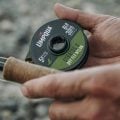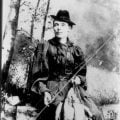How to Tie a Yuk Bug
Producer: Tim Flagler
“This big (ok I’ll admit it, somewhat ugly) fly is called the Yuk Bug. Although it can be used for trout, to me, it works best as a bass or pike fly. It’s a lot like a Woolly Bugger, but there’re definitely enough unique elements for it to be considered a pattern all its own.
I think the Yuk Bug benefits from a large, strong hook such as a Daiichi 2117 in size 4. I originally purchased the hook to tie big bombers but just couldn’t resist using them for this fly. After getting the hook firmly secured in the jaws of my tying vise, I load a bobbin with a spool of black UTC 140 Denier. Get the thread started on the hook shank, leaving a bit of space behind the eye. Take wraps rearward all the way down the shank to the start of the hook bend, to create a smooth thread underbody.
Natural gray squirrel tail is used for the tail of the fly. Snip a fairly ample clump free, down close to the tail, and strip out the underfur and shorter fibers from the butt ends. While pinching the clump in the fingers of your right hand, measure to form a tail about 2 hook gaps in length. Use tight wraps of tying thread to anchor the squirrel to the top of the hook shank, then lift the butt ends up and trim them off at a shallow angle. Continue taking thread wraps to bind down the snipped-off ends.
Squirrel tail hair is extremely slippery. Hence, the thread base to keep it from spinning around the hook shank. An ample drop of super glue, or here, Fly Tyers Z-ment, applied to the butt ends of the squirrel, and covered with tight thread wraps, will further help to insure the oh-so-slippery hair won’t spin, or pull free. End with your tying thread at the original tie-in point.
Medium-sized black chenille is used for the body of the fly. With a hook this large, you’re going to need to snip a full 4-card-width segment free. There will be some waste but you need that for ease of handling. Place one end of the chenille on top of the hook shank at the location of your tying thread and take thread wraps to bind it to the top of the shank, all the way back to the base of the tail. Start taking forward touching wraps with the chenille, up the hook shank, but behind your tying thread. Once you’ve gone 1/3 of the way up the shank, anchor the chenille with a few tight thread wraps then pull the remainder rearward, over top of the tail.
Medium-sized round rubber legs add a ton of motion to the Yuk Bug, particularly when it’s retrieved. From a strip 5” in length, pull off a single strand then fold it in half and find the folded segment’s midpoint. Lay the midpoint against the near side of the hook and anchor it with 3 or 4 reasonably tight turns of tying thread. Pull the front loop back and continue taking wraps of chenille in front of it, but still behind your tying thread. Keep wrapping the chenille until you’re another third of the way up the hook shank. Once there, secure it with wraps of tying thread and pull it back over top of the fly as you did before. Strip another strand of rubber leg material free and, once again, fold it in half and find its midpoint. Anchor the midpoint against the near side of the hook, and just as before, take wraps with the chenille in front of it but behind your tying thread. When you reach the eye, anchor the chenille with tight thread wraps. Then reach in with your tying scissors and snip the excess off close. You may have noticed that I nicked my tying thread here. It happens. The idea is to cover it up quickly so no one notices.
The hackle for a Yuk Bug is really up to you. Just make sure the feather’s long enough to take a reasonable number of wraps down a rather long hook shank. Here, I’m going to use a beautifully webbed and colored, super long feather from a ginger grizzly saddle. Snip a small triangular-shaped tie-in anchor at the butt end of the feather. Lay the anchor against the near side of the hook, and take nice tight thread wraps to secure it. Make sure it’s bound down really well, as you certainly don’t want it pulling free at this point. Check to make sure the feather is going to wrap correctly with the shiny or front side facing forward.
Start taking open spiral wraps rearward with your tying thread over top of the chenille, trying to avoid pinning down the rubber legs in the process. This can be a little fussy but it’s not too bad. Take a couple of thread wraps right at the base of the tail. Pull the rear set of rubber legs back and anchor them with a single thread wrap. Then pull the front set of legs back and anchor them with another single wrap. This will keep them out of the way as you begin wrapping the hackle. Take 2 or 3 turns with the hackle, one right behind the other, at the head of the fly. This will prevent the fly from corkscrewing in the water as it’s retrieved. Then, undo a single thread wrap to free the front rubber legs and keep taking rearward open spiral wraps with the hackle feather. When you get to the front of the rear rubber legs, free them by removing another single thread wrap. Continue taking wraps with the hackle feather, all the way back to the base of the tail then take thread wraps to secure it there. With the hackle bound down well, reach in with your tying scissors and carefully snip the excess off close.
Start taking open spiral wraps forward with your tying thread to counter wrap and protect the somewhat delicate and vulnerable hackle stem. Yes, you could’ve tied in wire and used it instead of thread. But to me, it’s much easier to use your tying thread and I don’t think the added protection afforded by the wire is really worth the effort. Of course, try not to trap hackle fibers as you wrap. When you reach the head of the fly, sweep the hackle fibers rearward and take wraps in front to hold them back. Continue taking thread wraps to build up a nicely shaped but fairly short head on the fly. Get hold of your whip finish tool and use it to do a 5 or 6 turn, back to front, whip finish behind the eye then seat the knot well and snip or cut your tying thread free.
Carefully work the rubber leg material underneath the thread wraps down along either side of the hook shank. Snip the midpoint of both loops so you’re left with four pairs of legs. You can then further tweak their orientation at this point, if needed. Trim the rubber leg material off so each leg is about a hook shank in length. Their lengths don’t have to be exact. Get hold of your head cement, here, Sally Hansen Hard as Nails, and apply an ample drop to the exposed thread wraps behind the eye. This not only keeps them from unraveling but also dresses up the fly a bit.
I prefer the Yuk Bug weightless but feel free to add wraps of lead-free wire to the body, a big conehead to the front of the fly or both. To get the weightless version down to where the fish are, I’ll use a sink tip at the end of my fly line. I find it easier to cast and think it presents the fly better at depth.”
How to Tie a Yellow Sally Stimulator
How to Tie a Zebra Midge











